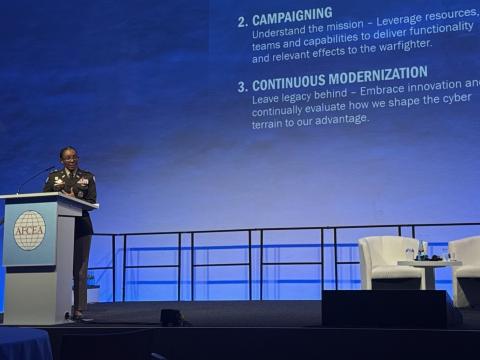Mind the Legal Gap: Embedding Full-Time Spectrum Counsel in DOD Frequency Management
The electromagnetic spectrum is the nervous system of modern military operations, yet the way the U.S. Department of Defense (DOD) staffs its spectrum enterprise has not kept pace with the complex, high-velocity legal environment that now shapes every major frequency decision.
During my tenure leading spectrum programs at Raytheon Technologies, I witnessed a fundamentally different model on the commercial side: regulatory lawyers sat “virtually” beside radio frequency (RF) engineers and spectrum professionals every day, steering both internal strategy and external advocacy in real time. Inside the DOD, by contrast, legal expertise is usually brought in only after technical positions are locked in or a dispute has already flared. That divergence in day-to-day staffing leaves the military department outmaneuvered in domestic reallocation fights, slow to resolve host-nation licensing issues, and perpetually reactive when confronted by agile commercial coalitions armed with specialized counsel.
The policy backdrop underscores why this matters. The 2023 National Spectrum Strategy calls for “expanded spectrum expertise” across the federal workforce, explicitly tying national-security success to a more sophisticated blend of engineering, policy and legal talent. One of the strategy’s pillars tasks agencies with attracting and growing that talent base so they can negotiate equitable sharing frameworks, protect mission-critical incumbents and still meet the surging commercial appetite for bandwidth. Pressure to deliver on that mandate is intensifying: the White House, the National Telecommunications and Information Administration (NTIA) and Congress continue to seek additional mid-band spectrum for 5G; the Federal Communications Commission’s (FCC’s) auction authority has been restored through 2034 with an explicit requirement to identify 800 MHz of new auctionable spectrum; and international forums are scrutinizing every U.S. allocation for potential repurposing. In short, spectrum is no longer a purely technical asset; it is a regulated commodity whose value and usability turn on finely crafted legal instruments.
Industry recognized this shift years ago. At Raytheon, I spoke with corporate counsel almost daily, often before speaking with my engineering counterparts. I would advance each high-level regulatory task, drafting experimental license applications, addressing export-control triggers hidden in host-nation agreements and negotiating indemnification clauses in spectrum-sharing terms, only after counsel assessed the risks, red-lined the language and confirmed alignment with corporate policy. Practically speaking, I was operationally supervised by our lawyers because every RF decision carried immediate contractual liability or competitive implications. That same triad—spectrum professionals, engineers and attorneys—followed us into the public arena. Whether I represented my company in the Aeronautical Frequency Telecommunications, Radiation, and Control Committee, shaped standards within the Manufacturers Radio Frequency Advisory Committee or took part in the United States International Telecommunications Union Association, my delegation always included counsel. The attorney’s presence was not ceremonial; it shaped our technical positions, the information we insisted the regulators provide and the compromises we held back on until airtight exit provisions were in place.
DOD offices, by contrast, usually bring in the service’s Office of General Counsel (OGC) or judge advocate general (JAG) only when a “one-off” legal question arises. While routine, low-risk filings may not warrant a lawyer’s day-to-day presence, many higher-stakes actions do. Spectrum officers and RF engineers may staff Interdepartment Radio Advisory Committee subcommittee papers, draft NTIA comments or answer commercial encroachment proposals without legal eyes on every draft. In those useful cases where legal nuance can tip the balance— such as complex sharing negotiations, contested reallocations or sensitive host-nation agreements —episodic engagement undermines two critical needs. First, working-level spectrum professionals lose the real-time coaching that could sharpen their positions before the documents circulate through internal boards and working groups. Second, the services arrive at FCC or NTIA proceedings without the immediate legal muscle that industry fields as standard practice, forcing government teams into a defensive crouch just as the opening gavel falls.
The fiscal consequences are tangible. During the Advanced Wireless Services, or AWS-3, reallocation, federal agencies were reimbursed for vacating the 1755-1780 MHz band only after intensive negotiations led primarily by the NTIA and agency counsel. The NTIA pegged the relocation and sharing cost for that slice alone at $4.576 billion, a figure the government secured because lawyers documented mission equities and negotiated payment terms before the auction notice appeared in the Federal Register. Few military departments had embedded attorneys in those talks; most relied on late-cycle consultations, which limited their leverage on timelines and cost recovery. Similarly, the 2020 AMBIT (America’s Mid-Band Initiative Team) sprint, which freed 100 MHz in the 3450-3550 MHz range to the commercial sector, succeeded only because a joint DOD–NTIA team, with lawyers in the room, hammered out sharing rules in just 15 weeks, creating a contiguous 5G band. That success story is often cited as proof that DOD can move fast, but it also illustrates that velocity came only when counsel was embedded from day one.
Operational risk overseas tells the same story. Combatant-command spectrum shops must comply with both U.S. regulations and host-nation telecom statutes before fielding new gear. Yet the Government Accountability Office found that DOD’s electromagnetic-spectrum governance is “dispersed,” short on full-time senior leadership and hampered by gaps in experienced staff, specifically calling out the need for clearer roles, processes and oversight. Many of those deficiencies can be traced back to limited legal bandwidth within day-to-day operations. When a foreign ministry of communications demands proof of harmless interference or raises liability questions buried in a status-of-forces agreement annex, spectrum officers often scramble to engage lawyers thousands of miles away, delaying fielding timelines and sometimes adding costs of delay that commercial firms would have anticipated and budgeted for months earlier.
Because the gap is structural, it demands a structural remedy: the services need a standing cadre of spectrum counsel, attorneys whose full-time job is to advise frequency managers internally and to face regulators externally. Co-located counsel could red-line NTIA filings before they leave the building, ensuring protection criteria align with auction rules and document relocation cost elements early enough to win reimbursement in future spectrum moves. Just as critically, those lawyers would mentor spectrum officials every day, teaching them how to frame arguments, preserve evidentiary records and avoid inadvertently conceding legal ground during rapid-fire technical exchanges with commercial actors. The internal day-to-day counsel is just as valuable as the outward-facing engagement, as it forges a common vocabulary and a shared risk picture long before the first external negotiation session convenes.
Cost arguments should not be an obstacle. Even a modest slice of the billions recouped in each major reallocation would more than fund a handful of senior attorneys. The AWS-3 transition alone provided agencies with $4.5 billion in relocation funds, a small percentage of which could seed an entire generation of spectrum counsel billets. Concerns about overlap with existing OGC or JAG functions are also manageable: military justice and operational law would remain JAG domain, while regulatory and commercial spectrum matters would flow to the new counsel, mirroring the divisions that already exist at the NTIA and the FCC.
The payoff would be immediate. With counsel in the room, DOD could respond to NTIA or FCC “action items” in days rather than weeks, improving its agility in hotly contested reallocation proceedings. Dedicated lawyers would bring antitrust, auction and commercial-lease expertise that technical officers rarely possess, strengthening the department’s negotiating position when compensation frameworks are drafted.
Each U.S. regulator already staffs its operations in this manner. The NTIA’s Office of the Chief Counsel and the FCC’s Office of General Counsel have attorneys embedded in every policy decision because the agencies know that technical judgments cannot be divorced from legal ramifications. Industry mirrors that structure because real-time legal insight is simply good business. Until the military departments offer their spectrum professionals the same daily access to specialized counsel, they will continue to negotiate with one hand tied behind their backs, ceding initiative to commercial actors and risking operational readiness. Embedding full-time lawyers inside DOD spectrum teams is not an optional luxury; it is a mission-critical investment that aligns defense practice with 21st-century spectrum diplomacy and ensures warfighters retain decisive, assured access to the airwaves they depend on.
James E. Ortega is the director of the Navy and Marine Corps Spectrum Center, overseeing global electromagnetic-spectrum governance and operational support for U.S. naval and Marine forces. A retired Army veteran turned senior civilian leader, he has more than 30 years’ experience spanning joint operations, defense industry program management and federal policy. Ortega is recognized for modernizing spectrum-certification processes and mentoring the next generation of spectrum professionals.






Comments